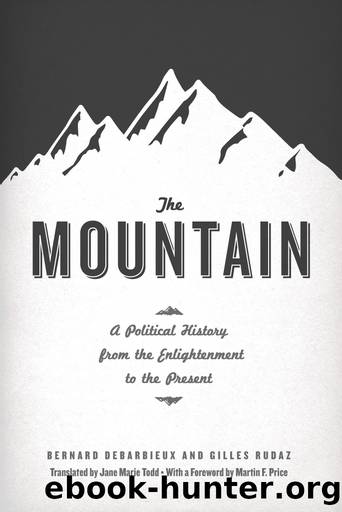The Mountain by Bernard Debarbieux;Gilles Rudaz; & Gilles Rudaz

Author:Bernard Debarbieux;Gilles Rudaz; & Gilles Rudaz [Debarbieux, Bernard]
Language: eng
Format: epub
ISBN: 9780226031255
Publisher: University of Chicago Press
Published: 2015-07-30T05:00:00+00:00
Nature and Heritage Protection in the Matopo Hills
The model of national parks and nature reserves in the mountains of colonized regions spread in a manner similar to that of forest policies. Following approaches already taken in the United States and Europe, the colonial powersâand after them, the independent nation-statesâpromoted the constitution of natural spaces, privileging mountain regions. According to current estimates, between a third and a half of the surface area of protected areas is located in mountain regions.69 The appeal of mountain regions in the tropics owes a great deal to the work of naturalists and artists in the twentieth century, who touted the lush vegetation and extraordinary beauty of the peaks.
Protection measures often apply to the same spaces that were previously protected as hunting or forest reserves, where traditional practices had already been restricted or prohibited. These spaces were thus readily redefined as emblems of virgin nature. Mount Meru provides a good illustration.70 The creation of such protected areas has often been justified by a critique of the community management modes the local populations had adopted, sometimes accompanied by forced settlement policies targeting the nomadic peoples.71
The national park in the Matopo Hills of Zimbabwe is a particularly good illustration of that process of reassessing a mountain region.72 The first descriptions of the region attest to the interest of British colonists in the siteâs geological curiosities and in the forest potential of the highlands. They also indicate a lack of interest in the relationships the local populations maintained with their surroundings. In 1896 an insurrection of the autochthonous populations, called the Ndebele, forced the colonial administration to take seriously the presence of the indigenous peoples and to arbitrate between the various interests and conceptions in place.
Cecil Rhodes, founder of the British colony, chose to negotiate with the Ndebele regarding the status of the highlands. He acknowledged the sacred value that they attached to the site and arranged for protection of the highest elevations. In so doing he also offered Europeans who loved the wilderness a âwhite playgroundâ and pleased scientists who had pointed out the interest of the region.73 Conversely, in placing himself on the side of the scientists and the Ndebele, Rhodes frustrated the desires of a portion of colonial society, which was seeking to exploit the site.
After Rhodesâs death in 1902, however, the protection policy governing the site changed. The colonial administration decided to create a nature reserve. Geological formations and archaeological relics were recognized for their heritage value, and the uses the autochthonous peoples made of the region at the time were judged harmful to its forest and to its scenic landscapes. The rights of use of the local populations, though initially preserved, were abolished with the creation of a national park in 1926, and the populations were completely excluded from the park in 1952.
The case of Matopo Hills demonstrates the preeminence of a naturalistic and environmentalist conception in assessments of the qualities of a mountain site and in the adoption of a protection policy. Ultimately that policy turns out to be indifferent to the interests of the autochthonous populations.
Download
This site does not store any files on its server. We only index and link to content provided by other sites. Please contact the content providers to delete copyright contents if any and email us, we'll remove relevant links or contents immediately.
Essentials of Geology by Stephen Marshak(374)
Spectral Geometry and Inverse Scattering Theory by Huaian Diao & Hongyu Liu(260)
Probably Overthinking It: How to Use Data to Answer Questions, Avoid Statistical Traps, and Make Better Decisions by Allen B. Downey(255)
The Readable Darwin by Pechenik Jan A.;(248)
How to succeed in EPSO numerical reasoning tests by Franco Reverte José María(222)
Great Ways to Learn Anatomy and Physiology by McKissock Charmaine;(221)
Quantum International Relations by James Der Derian(217)
Weathering: Types, Processes and Effects: Types, Processes and Effects by Matthew J. J. Colon(215)
Research and Publication Ethics by Santosh Kumar Yadav(214)
Dark Matter in the Universe by John N. Bahcall(209)
Mathematical Models in Economics. Lections by Shananin(209)
Fusion of Defects by Arthur Bartels; Christopher Douglas; André Henriques(199)
Mathematics Booster-1 by Singh Manoj Kumar(195)
The Structure of Scientific Inference by Mary B. Hesse(192)
Pearls from a Lost City: The LVOV School of Mathematics (History of Mathematics) (History of Mathematics, 40) by Roman Duda(188)
Sampling by Lohr Sharon L.;(186)
Hydrocarbon transformations in sediments from the Cathedral Hill hydrothermal vent complex at Guaymas Basin, Gulf of California ââ¬â A chemometric study of shallow seep architecture by unknow(183)
Flora Unveiled by Taiz Lincoln;Taiz Lee;(179)
Social Insects: Structure, Function, and Behavior : Structure, Function, and Behavior by Emily M. Stewart(174)
